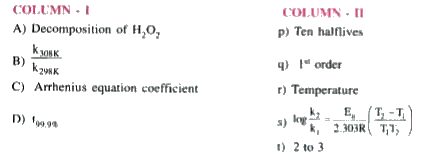The energies of activation for forward and reverse reactions for A2+B2→2AB are 280kJmol−1 and 400kJmol−1 respectively. The presence of catalyst lowers the activation energy of both forward as well as reverse reactions by 100KJmol−1. The enthalpy change of the reaction A2+B20→2AB in the presence of catalyst will be (in KJ mol−1)Solution in Telugu
−120
−280
+120
−300
The correct Answer is:A
ΔH=[A.εf−A.ε(b)]=280−400=(−120)
Topper's Solved these Questions
- CHEMICAL KINETICSBOOK - AAKASH SERIESCHAPTER - CHEMICAL KINETICSEXERCISE - PRACTICE SHEET-3 (LINKED COMPREHENSION TYPE QUESTIONS)
6 Videos
- CHEMICAL KINETICSBOOK - AAKASH SERIESCHAPTER - CHEMICAL KINETICSEXERCISE - PRACTICE SHEET-3 (MATCH THE FOLLOWING QUESTIONS)
2 Videos
- CHEMICAL KINETICSBOOK - AAKASH SERIESCHAPTER - CHEMICAL KINETICSEXERCISE - PRACTICE SHEET-2 (INTEGER ANSWER TYPE QUESTIONS)
6 Videos
- CHEMICAL KINETCSBOOK - AAKASH SERIESCHAPTER - CHEMICAL KINETCSEXERCISE - EXERCISE - 3.2
45 Videos
- CHEMICAL THERMODYNAMICSBOOK - AAKASH SERIESCHAPTER - CHEMICAL THERMODYNAMICSEXERCISE - Additional Practice Exercise
54 Videos
Similar Questions
For a chemical reaction A→ products, the following equation is found to be followed, logK=16.398−2800T
Arrhenius factor for the reaction is ______
View SolutionMatch the following columns

View SolutionFor a reaction the graph drawn between half life period and reciprocal of initial concentration(1/a) gives a straight line with positive slope. The magnitude of the slope is 500 and iniital concentration of the reactant is 2M. If the initial rate of the reaction is represented as x×10−3 units, then the value of x is _____________
View SolutionDiscuss on the kinetic spontaneity of a chemical reaction. Is a slow reaction spontaneous? Why?
View SolutionWhich among the following is not an exact differential?
View SolutionIf a reaction A+B→C is exothermic to the extent of 30KJmol−1, the the forward reaction has an activation energy , 70KJmol−1, the activation energy for the reverse reaction is
View SolutionThe energies of activation for forward and reverse reaction for A_(2)+B_(2) hArr 2AB are 180 kJ "mol"^(-1) and 200 kJ "mol"^(-1) respectively. The presence of catalyst lowers the activation energy of both (forward and reverse) reactions by 100 kJ "mol"^(-1) . The enthalpy change of the reaction (A_(2) + B_(2) rarr 2 AB) in the presence of catalyst will be (in kJ "mol"^(-1) ):
View SolutionIf the activation energy for the forward reaction is 150 kJ mol^(-1) and that of the reverse reaction is 260 kJ mol^(-1) , what is the enthalpy change for the reaction
View SolutionThe energies of activation for forward and reverse reaction for A2+B2⇔2AB are 180kJmol−1 and 200kJmol−1 respectively. The presence of catalyst lowers the activation energy of both (forward and reverse) reactions by 100kJmol−1. The enthalpy change of the reaction (A2+B2→2AB) in the presence of catalyst will be (in kJmol−1):
View SolutionIn a reversible reaction , the enthalpy change and the activation energy in the forward direction are respectively −xkJmol−1 and y kJ mol−1 is
View SolutionThe energies of activation for forward and reverse reactions for A_(2)+B_(2) harr2AB are 180kJmol^(-1) and 200kJmol^(-1) respectively. The presence of catalyst lowers the activation energy of both (forward and reverse) reactions by 100kJmol^(-1) . The enthalpy change of the reaction (A_(2)+B_(2) to 2AB) in the presence of a catalyst will be (in kJmol^(-1) )
View SolutionIf the activation energy for the forward reaction is 150 "kJ mol"^(-1) and that of the reverse reaction is 260 "kJ mol"^(-1) , what is the enthalpy change for the reaction ?
View SolutionFor a given reaction, energy of activation for forward reaction (E_(af) is 80 kJ mol^(-1).DeltaH=-40"kJ mol"^(-1) for the reaction. A catalyst lowers E_(af) to 20 kJ mol^(-1) . The ratio of energy of activation for reverse reaction before and after addition of catalyst is :
View SolutionThe energies of activation forward and revers reaction for A_(2)+B_(2)to2AB are 180 kJ mol^(-1) and 200 kJ mol^(-1) respectively. The pressure of a catalyst lowers the activation energy of both (forwar and reverse) reactions by 100 kJ mol^(-1) . The magnitude of enthalpy change of the reaction (A_(2)+B_(2)to2AB) in the presence of catalyst will be (in Kj mol^(-1) ):
View SolutionThe energies of activation for forward and reverse reactions for A_(2)+B_(2) rarr 2AB are 180 kJ mol^(-1) and 200 kJ mol^(-1) respectively. The presence of a catalyst lowers the activations by 100 kJ mol^(-1) . The enthalpy change of the reaction (A_(2)+B_(2) rarr 2AB ) in the presence of catalyst will be (in kJ "mol"^(-1)) :
View Solution
